Features of the Relief of the Old Continents. Peculiarities of nature and population of Pivnichnyh continents. Team card for the group "biogeography"
The most significant and contrasting relativism is seen in America. At the її Teritorії roztashovanі gіgantska vysoka gіrska system Andy and vast lower regions of the Amazon, Laplatska and іn. Downhill continent - Australia (mid-height 210 meters). Antarctica is still much higher (up to 2000 meters) for the ice cover, the bottom of the surface is raised in the middle by 410 meters. Africa as a whole - to reach the high continent (mid-height 650 meters), the protest hypsometric level of the surface does not appear in contrast: in the relief they overlap the mountains, plateaus and flatlands. There are no greats on the mainland gir systems and the great lowlands.
On the surface of the Old Continents, there are similar rice, which is crocheted, in the first place, with the stages of the foreign geological history. Rivnini, plateaus and flatlands occupy the central regions and territories of all ancient continents, and the great Hirska lands are spread around the outskirts - at the entrance Of America and Antarctica, at the descent of Australia, at the holidays and celebrations in Africa. Significant part of the territory of all chotiers of the Ancient continents is a fragment of the ancient Gondwanaland. The development of Gondwanaland and the breakdown of the continents came to the fore, but Africa, which had previously enveloped the center of the super-continents, may even be a platform structure, which is surrounded by lines of breaks. Only at the end of winter and winter, the mainland went to the outskirts of Gondwanaland, there is a warehouse in the early days of the Hercynian and Alpine orogeny. Warehouse belts fit to the Gondwana platform structures of Indian America and Antarctica at approach, Australia - at once.
Relief of platform blocks earth measles folds by neotectonic ruchs are epirogenic and different in nature. The orographic structure of the cyclical parts of the continent is zoomed in by old tectonic processes. They perevazhaє directly relєf: in the great sineklіzah roztashovanі nizinnі rіvnini: Amazonska, Orіnokskіy, Laplatska nizovini in Pіvdennіy Ameritsі, pіvnіchny Skhid sugar in Afritsі, Great Artezіansky swimming pool in Avstralії, submarine well Bentlі in Antarktidі and on billboards sformuvalisya in bіlshostі vipadkіv pіdnesenі rіvnini, flat and brilliant mountains.
Some of the bottoms of the ulovin, formed in the syneclises, are located on the top of the high hypsometric level: Pivnichnoi in Africa May the absolute height of the bottoms from 250 meters to 400 meters, Congo - from 350 meters to 500 meters, Kalahari - from 950 meters to 1000 meters. Ale the stench is still lower, lower navkolishny flat and burn. In the gorges, for a long hour, the products of the ruins have been accumulated.
On the Pivdenny continents є dilyanka and brutal relfu: high plateaus in the boundaries of the syneclises of Parani, Karru, Kimberli, Canning. A lot of regions have been formed in the areas of the front and edge platform progines of the Andes, Atlas, Cape and Schedule-Australian gir systems.
The main types of endogenous relief (morphostructures)
Morphostructures of ancient platforms
The basis of the structure in the inter-platform structures of the Old Continents is the basement of the ravine and the flat shields of the Precambrian platforms and the strata and accumulative ravine of the plates of the gypsometric plate.
The basement of the flat and the flat, stems by the processes of denudation in the boundaries of the ancient folding structures of the shields, occupy a great expanse on all continents. Smell є in the Guian and Brazilian Highlands, in the Western Australia and in the Western Antarctica. A particularly characteristic type of relief for High Africa and regions in the way of crystal rocks on the Leono-Liberia and Regibatsky shields. Accumulative ravines may be surrounded by a wider, rostashovuyuchis, head rank, along the outskirts of the continents, or in the central and axial parts of the internal platform syneclises. Layers of the lower part, the upper part of the plateau and the widening plateaus on the plates of the platforms more broadly.
Relief of glib evolves of platform girders, widespreads on the Pivdenny continents, folds of differentiated knock-off ruks along breaks in the boundaries of platform shields, and in small slabs. Such mountains are for the Guiana, Brazilian, African African mountains, the outskirts of the Holy Africa, Western Australia and the Western Antarctica.
Large areas on the Indian continents occupy the morphostructures of the lava plateaus on the effusive slopes, so as the breakup of Gondwanaland and differentiated by breaks along the entire history of the formation of the surface of the Indian continents, volcanoes were formed by volcanics. The plateau, which may, as a rule, have a step-by-step character, occupy great areas in the boundaries of the Parani syneklizi, on the Efiopska nagir'ya, and the minority of the dilyanka practically in all areas, which have become aware of the differentiation of the ruins. On the ancient Gondwana platforms there are also volcanic masivi and girski lantsyugi. In the rift zones of Africa and Antarctica, there are uneasy progress and death. Form a relfu, tied with volcanism, characteristic of the mountains of Ahaggar and Tibesti, the cliffs of the Red Sea, for the African African mountains. There are great active volcanoes: Nira-Gongu, around the craters of the Massivs of Meru and Kilimanjaro, Cameroon and others. There are even more volcanoes and volcanic structures: cones, shields, calderas, sometimes filled with water. Є Great volcanoes і in Antarctica, for example Erebus. In Australia, there is a lot of volcanism, ale of volcanic plateaus є on the platform valleys of the western part of the continent, for example, on the descents of the Kimberli plateau.
Morphostructures of crumbling belts
Relief of crumbling belts, scho adjoin to the Gondwana platforms, has a foldable character, albeit with all its versatility, and here it is possible to simulate deyaki zagalny rice and regularities of morphostructural growth. In all girskiy systems of fold belts of the ancient continents, young tectonic zones alpine and pacific orogeny, oblamovuyut continents from the side of the oceans.
To navigate the Epipaleozoic Skidno-Australian belt can also be "young" lined at the glades of sharp arcs, like supervising the Pacific Uzbeks of Australia. In the Andes, the Coast of the Cordille is also stretched from the side of the Pacific Ocean, in which, mabut, the processes of folding are also the result of incomplete subduction oceanic plates... The coastal zone of the approach of the Indian America, as well as the islands of the arch of the Western Australia, supervised glide-water troughs... Nevysokі antiklіnalі abo volcanіchnі lantsyuga gіr may be even greater over the bottom of the zholobіv. In some cases, for example, in the regions of the Central Andes, the magnitude of the height of the relief is greater, lower than the height of the Himala. In cich girskih lantsyugah, the processes of extreme volcanism, є post-volcanic manifestation, the top of the steps of seismicity.
Good see the volcanoes and geysers of New Zealand, the earthquake, which is not often catastrophic, in the part of the coastal Cordillera of Chile and Peru, folded in winter in folds by Cenozoic rocks or volcanogenic material.
The orotectonic zone of the Andes is approaching when the entire middle of the Andean systems - rejuvenation and regeneration of bryl-fold and fold-bryl high and mid-range ridges of the Western Cordillera.
The stench is continuously drawn from the very winter of the Andiysk systems and from the Darien inflow to the Magellanic channel on the river. W 28 ° S NS. tsey lantsyug ridges will be called Golovnoy, and from 42 ° S. NS. - Patagonian Cordilleri. The stock here passed in the era of the Alpine orogeny. The neotectonic ruks of the Alpine anticlinoria boules were lifted along fractures at a high altitude (4000-6000 meters). Golovniy Kordilyorі is located whish point Andes - Aconcagua (6960 meters). In the whole orotectonic zone, Meso-Cenozoic volcanism has been widely manifested in the viglyad granitoid intrusions, lava curvatures, vimerlich and inactive volcanoes in the Western Cordillery of the Central Andes, Head and Patagonian. Deyaki from the volcanoes may be at the height of 6,000 meters, and they remain active until the present hour.
At the turn of the road (from the island of Guakhira at winter to 38 ° S. Sh.) The ridges of the Skhidnoi Kordilyuri are stretched. Tse vіdrodzhenі brewery brilіvі and brilіvі gory, the leading rank on the Hercynian pіdstavі.
The ridges reach the great heights - 4000-5000 meters, near the top over 6000 meters At winter (close to 3 ° N. Sh.) Even on the skid, there is a stick of the rugged belt and ancient platform structures in motion tectonic ruks boules were covered with platforms, between 20 ° and 37 ° S. NS. There are systems of evolved glib girders in the Precambrian and Paleozoic folds. Tse Pampinskie (Pampiyskie) Sjurri i Prekordilyeri. Roughly vuzki brilovy ridges are divided by valleys.
Orotectonic belts of the Andes are divided by zones of depression. Between the Coastal and Western Cordilleras there is a swamp of sinking.
In the middle of the roztashovan, for example, the depressions of the Atacama heaths, in the pivdennishe - Pozdovzhnia (Central) valley of Chili, until which there are many lancers of volcanoes along the lines of fractures.
Mіzh Zakhіdnoyu and Shіdnoy Cordilleras at pіvnіch from 10 ° S. NS. stretch for higher graben-shaped late depression, occupied by the valleys of the rivulets, the bottoms of which lie on a significant height.
Along the lines of breaks in the numerical volcano, including those of the day - Cotopaxi, Sangay and іn.
Zakhidna and Skhidna The Kordil'ri in the Central Andes are framed by high-pitched rivnini - puni, which are formed in the boundaries of the middle massif, partly overlapped by lava curtains.
A long time ago, she was shaved at a higher low hypsometric level, lower navkolishny mountains (3000-4000 meters). At the same time, the material is known from the gir, and here weak accumulative ravines and lava plateaus are formed, surrounded by remnant massifs and volcanoes. Before the boules of the number of lakes in the gorges, before the present hour it was dry.
Pivnichni Andi is seen as a tectonic break in the so-called Caribbean Andes. The structure, which completes from the beginning of the Caribbean-Antilles, collapses the zone, the yak, which is allowed, was formed in the western part of the Tethys ocean. The zone is seismic, there is no volcanism here.
Andy, on the last day, through the system of islands of St. George, Holy Sandwich and St. Orkney of Orkney, get together with the mountain lancers of Western Antarctica. The birch mountains of the Antarctic Peninsula, the western Uzbek coast of the mainland and the so-called Antarctic Andi (Antarctica) continue to advance the tectonic zones of the Andean rukomny belt (height - 3000-4000 meters, on the Land of Elsworth, there are 51 meters of the continent. The whole fold of the Meso-Cenozoic belt is seen from the Precambrian and Paleozoic structures of the Western Antarctica by a system of fractures, which goes from the Weddell Sea to the Ross Sea. They are bridged by the horst ridges of the Transantarctic glib mountains. Before the breakdowns occur volcanism on the mainland and the islands.
Skidno-Australian girsk system, which will provide the Gondwans with platforms from the start, is much simpler in terms of orographic structures and below the absolute heights, lower than the Andiysk ones. Vona prostrated for 4000 km uzdovzh shidny uzberezhzh Australia and Eddiena from sharp arcs border seas... Here you can get over the grains of brillian fires, low and middle ones: as a rule, their height is 1000-1500 meters (the most important point of the town of Kostsyushko is 2230 meters).
The Tsia Girska Land of Bula was established by differentiated neotectonic ruks on the site of the post-Herzian peneplain. Rukhi supervodzhuvalysya vilami lava, ale of the current volcanism here is not. The mountainous Australia is also characterized by low seismic activity, which in turn imposes on its general tectonic stability in the Danish hour. The ridges may steep skidny, and down to the inland valleys, a gentle sloth in front of the mountains, which is called down in Australia, descends.
Before the African platform, the tornado belt was also attached to the pavnos, in the boundaries of which the Atlas girsk system was formed. Here the same regularity is manifested: from the outer side of the mainland Midland Sea rostashovany ridges of young folded gir - Er-Reef and Tel-Atlas. A great part of the Atlas system is a kind of fermentation of food brilovy mountains and mіzhgіrskі plateau on the Hercynian podstavі. At the pivnichnyh ridges, the high step tectonic activity, often the earthquakes.
Burn the systems of poor quality - in the middle 2000-2500 meters. Most of the stench can be reached at the Visokiy Atlas (m Tubkal, 4165 meters - the point of the system). Young alpine ridges Er-Rif and Tel-Atlas can reach 2500 meters.
Kapska girskaya system, which borrows the extreme winter of Africa, is a type of mountain with a settled folding structure.
Folding ruch took place here in the era of the Hercynian orogeny, since Gondwana Bula was on the single continent and the ancient edge of the African continent was part of the crumbling belt on the outskirts. The processes of folding ended here in the three-year period, and immediately after the cycle, the intensively decreasing territory began to decline. Girski spruce, yet not smoothed the denudation, bullets overcame the choked sea litter of the Mesozoic vik. Neotectonic events, which hunted all of Pivdenna Africa in the Paleogene-Neogene hour, brought before the Hercynian anticlinal ridges appeared on the surface. Pooh siege breeds, which overwhelmed the folds of the structure, boules of knowledge. For the sake of supravodzhuvavsya to the strength of the glibinous erosion. As a result, the Cape Mountains are a splinter of parallel anticlinal ridges with a height of up to 1500 meters, separated by later synclinal valleys. Їх cross-flowing in the schools of the river canyons, some of them confined to tectonic tremors.
Features of the exogenous relєfu (morphosculpture)
The exogenous factors that shape the surface of the ancient continents, there is a role to supervise the processes of vitality (hypergenesis), the robotic surface and underground waters, in Africa and Australia - robots in the winter, in Antarctica and in the regions of the Andes - ice.
The role of the processes
The diversity of all exogenous factors on a large part of the Northern Tropical continents in the opposite direction is in high temperatures. Hypergenesis grows differently for the genesis and stock of the giant breed: crystalline, volcanogenic, sediments. Їх upper sphere in significant open spaces є measles vivitryuvannya, which were shaped by stretching for a trivial hour (reproducing from the Mesozoic) in small minds.
The whole zone of hypergenesis, both ancient generations of the Precambrian basement and Proterozoic syneclises, as well as more young sedimentary and efusive deposits. Try it, get sick of measles. girskikh breeds... On the great expanses, the stench was formed in the minds of a disturbed disturbance, as if it was not a ric one, but a seasonal one, and is a product of biochemical processing (in the main ferralization) of surface rocks. Measles cysts are stored from finely dispersed particles of clay minerals and hydroxides, aluminum and manganese. Most of the minds are formed on the basis of the development of glybin, the formation of solid gold or gold-alumina laterite balls. The need for such feeds is from decils up to hundreds of meters. It is not possible to lay down and from the triviality of formulation, from the warehouse and from the structure of various types, and from the current processes, both to the knowledge, and to the operation.
In the arid regions of the Northern Tropical continents, there are dylyanki of recreational hydromorphic crust - the decline of pluvial epochs. The stench is especially wide on the plains and in the mountains of Australia and Pivnichnoy Africa. Zal_zysti lateritny measles, riyuyuchis pіd inflow of physical vivіtryuvannya, perevoryuyutsya in rossipy red-colored crushed stone, pebbles, squeak.
The processes of physical vivacity, widely developed in areas outside the climate through great temperature differences, destroy the rock. State crests and peaks, skeletons of chimeric forms with nisha, arches, vistups are set up. The product of ruinuvannya is a great ulamkovy material - to seethe the lower parts of the school and the navkolishni ryvnini. Tse kam'yanistі kestrelі - Gamada (khamadi). The stench is confined to tectonic days, volcanic masses, intrusive remnants and so on. I are widely spread in all arid zones of the rivers and mountains of the Ancient continents.
Desquamation (peeling) processes are developing on the surface of hard rocky rocks, and so called “hollow tan” - skelnies are covered with dark floats. These processes are not only in the hot, arid regions of the Northern Tropical continents, and in Antarctica, in the oases and mountainous regions, but they are moving in flickers over the surface of the ice.
fluvialny relєf
For the river bed of permanently vologic regions with an equatorial, tropical and subtropical climate, there is a characteristic low erosive direction of the channels. On flat stratal and accumulative valleys, measles vivitryuvannya is water-borne, there is a mass of fine earth, and a thin material is deposited. The rivers are constantly bottled, changing the channel, blooming along the wide bottoms of the valleys, rolling on the sleeves, spreading out by low islands, making meanders.
Aluvial ryvnini - systems of zaplav, zvichy decilkoh rivniv, and wide supra-float teras - the main type of fluvial morphosculptur in the boundaries of tectonic depres: Amazonian, Orinokovskiy, Lapalalatskaya, Pianogov Murray Basin - in Australia. It is not for nothing to bear the name of draining richok for a large number of rivnins.
There is not a lot of variation in the channels of the rich-water African rivers, which flow from the mountains and flatlands and cross over to the outskirts of the mainland, such as, for example, the upper and lower stretches of the river. Congo (Zaire) or lowering the rychok Zambez, Pomaranchevoi, Kunene and іn.
Many small rivers may pass the later stages of the fall with the rapids and waterfalls, which tend to rise up the hill over the course of the current. The price cannot be explained only by the youth of the valleys, so as the actions of them, for example, the upper course of the river. Congo, developed in more stable tectonic minds from the Mesozoic. Behind the figurative wislow of the French geographer Biro, the little girls "re-equip" the nerves of the relfu, and not rush through them. Tse is tied, apparently, to this time, which carries a rush in the main fine earth. The great ulamkovy material can be quickly disposed of by biochemical processes in the minds of high temperatures and great lightness, so that it doesn’t put a load on it and doesn’t cause too much heat, it’s more than the bottoms of hard valleys, which are often folded. The channels are not often armored with salty crusts and floats. In areas with a changing climate of equatorial-tropical latitudes, lateritic shells lie on a small glibine or navigate directly on the surface. Rush, the stench turns into solid pebbles, like a volody, meaningful poses. Ale at the same hour later, measles armor the bottom of the channels, slowing down. As a result, both in gradual, and in changing paths with more stable tectonic minds, the erosive occasion is not glib and the relief of myaky obrisi.
In the wilderness of Pivnіchno and Pіvdennaya Africa and Australia, the relict erozіynі forms of relєfu - the channels of colonic rivers and streams (wadi abo Ueddei of Africa, similar to the Arabian, and the cries of Australia) have been saved.
And the sloping streets of the valley stretch for tens or hundreds of kilometers and end, as a rule, in the valley of dry lakes. At the edge of the angry, angry boards, streams of water flow along them. Tse zavazhaє general knowledge of the channels, as I know zagliblyuyutsya write such a period of skin. After an hour, the boards become unstable, and there are large lakes of lakes, transforming into lakes, chill in salt. Such traps on the Sahari winter descent and in the boundaries of Atlas are called Shotta abo sebkhas.
Solifluktsionnye and zsuvniy relєf
In case of permanent or seasonal waterlogging, schilovy sticks develop. The rosy, fluffy soil literally flows between the edges and stems of the roselin, wandering down the grasses, winding and gently sloping. Winikayut sol_fluktsionnye form. Widely broadening the process of establishing zsuv_v. The development of schilovy processes is quick to accommodate, as there is a tall line, so that you will be impressed in the result of the state dyyalnosti people. Virubuvannya and vipalyuvannya lisiv and chacharniki overgrowths, uncompromising vipas of thinness and іnshі melt on a tall line, so that the soil is squeaky and difficult to drink and wine material down through the grains, the process of watering until it is wrapped In the process of spraying, the appearance of solid water spheres - lateritic shells, and in small parts they light up close to the surface of monolithic crystalline rocks.
On more flat and gently sloping dalyankas of the surface, in the fluffy barks of vivitryuvannya, suffosion also develops, fixing depressions.
The scope of surface and subterranean waters should be produced as a whole until the establishment of a weakly wavy, gently sloping relief with outcrops, mountains, ridges, and ramps of table plateaus. Such surfaces varied during the period of a stable tectonic regime throughout the entire geological history.
The emerging neotectonic ruins brought them to a different height, in the process of picking up the stench, they were given an intensive dismemberment, but all the same, in the history of the Great continents, there were fragments of peneplains and pedagogues of the vivid geological landscape. On all continents, there are overlaps of decilkoh on top of virivnyuvannya.
The remaining tables are plateaus with a height of 1000-1500 meters, and at least 2000-3000 meters are fragments of a dismembered "Gondwana" surface, like a bulwark was opened by a denudation in the Jurassic period. The stench є in the boundaries of the mountains of Africa and the Middle Ages. Widely broadened by larger peaks of the surface, the stems by the denudation cycles of the deceased credit - oligocene, neogene and nareshty, Pleistocene cycle, which is trivial until the present hour. As a result, on the Pivdenny continents, there are often tables of mountains and plateaus, flat-topped mountains and weakly wobbling ravines, slowed down by remnants or low ridges on the outskirts of large, large-scale roots, on large scale ones. Penetrating ravines with outliers are even more characteristic of Western and Central Australia. Form tables are often tied with obvious armor plates, for example, solid beads and quartzites: Brazilian shappadi, Guiana tepuy, tables of the mountains of the Holy Africa.
eoloviy relєf
Forms of green accumulation: small types of brekhuniv, widening of the ridges in quiet areas of arid regions, as from the surface of the folds (squeak with ancient richkovy abo sea alluvium). The sandy relief characteristic of the coastal kestrels to the entry of the Middle Ages and the Middle Ages. Great food open up the wilderness of Australia є, the head rank, the ridges, knit right along the panuyuch winds. In the African food estates (in the mountains of the Sahari, in Namib), you can know practically all types of green accumulative relief. Sugar є okremi sand dunes, which reach hundreds of meters in height.
In the arid regions of the Adenian continents, there is widespread expansion and formation, linked with deflation (formation) and corrosion. Skelnias are transformed into kam'yani mushrooms, they are often played on the Brazilian Plateau, in the arid mountainous regions of all the Ancient continents. On the dry plateaus of Pivdennoi Africa є dilyanki, degraded skeletons, reworked with a spy robotic vivitryuvannya and vіtru in gigantskі kulі and the shape is geometrically correct.
karst relief
On the Vіdminu from the Pіvnіchnyh continents on the Pіvdennyh wіn, there is a wider area. Yogo approval of the wimag of the day in karst from a sufficient number of fallen trees. Such districts in the boundaries of the Pivdenny continents are not large.
The most widespread karst in Australia, de vapnyakovs go to the surface on the Barkli plateau in the boundaries of the subequatorial climatic belt with summer litter, near the Western Australian Mountains, deaf fall tsiliy rik, On the Rivnin Nallarbor, in the subtropical climate with winter litter. Near the pool, the rychok of Darling and Murray, under a ball of aluvial litter, the vapnyaks and caverns of karst flood.
Karst forms of rural districts are growing fallow among the world's minds. At the winter and winter descent of Australia, the main tropical Bashtovian karst with end Vapnyak outliers is established. On the plains and plateaus of the subtropical belt, the broadening of the most popular forms of naked and covered karst. Near the mountains and on abrasive ledges there are numerous peaches, grottoes and nis. At the bottom of the vapnyak ledge, like the Nallarbor Ravine, it is shaved off to the Great Australian Waterfall, the sea is supposed to boil from the outcrops of the sub-water karst dzherels. The coastal shave has a scalloped shape, so as the sea is intensively razchinyaє the girskuyu breed of bridle troughs, perpendicular to the line of the coast. Vuzki vdayuyutsya gliboko vdayutsya into the land of the inflows, which fills the rounded steps of the coastal ledge.
In African and Indian American karst forms are being developed on small dilyankas in the Andes, on the Brazilian Plateau (there are і pechery), in the Middle and Eastern African countries. Significant areas of karst form the profile occupy in the Atlas Girskiy system, on the eastern part of the Somalia, and in the new sugar (for example, in the cuest beds of Tasilli, make the Ahagarr heat well). In the cichs of arid regions, the karst will be covered with pluvial epochs of the Pleistocene (such a relief is of a small nature). In the karst caves of the Tasilla and the other ridges, there are known of these little ones of the first people, who inhabited the Sahara, if it was not a waterless wilderness.
relєf beregiv
The types of shores of the Pivdenny continents are even more profitable. Among them are є і first-rate, і dismembered, і stems of abrasion and accumulative power of the sea, non-wave and destructive processes. Even wider is the widening of the Uzbek coast, formed by skidding rukhs, so as a large part of the outskirts is the same passive outskirts of the continents. The stench, as a rule, is lined with high-pitched smogs of the accumulative lower reaches of the higher steep curvatures, and the chunks of abrasion. Wide lagoon shores, often overgrown with mangrove thickets. The mangrove type of Uzbek is characteristic of the low coastal areas in the equatorial-tropical regions of the ancient continents.
Tsikava is located on the outskirts of Australia, de coastal lines are supervised by abundant coral spores.
Here є uniquely established - the Great Bar'erniy Reef.
There is a chain of coral reefs and islands, which stretched across the coastal Uzbek continent for 2300 km and was lifted out of the coast by a wide lagoon. Uninvolved to finish great in motions the view from the coast of the mainland, the reef is significantly infused into nature and the state of the Uzbeks. About the Great Bar'erniy Reef breaks through the ocean, it will be too much for the current, as it goes to the mainland, allowing for a special mind for the life of organisms in the calm and warm waters of the lagoon. Ruinuvannya reef buds, which are seen as natural and anthropogenic processes, there can be hundreds of inherits natural complexes and the population of the Australian Uzbek. Coral reefs are superbly guided by the Uzbeks of Australia and Old America and are practically on the go near the city's coastal line of passive outskirts of the African continent.
Lion's Relief
Lodovikov, including the religious forms of the relєfu, so characteristic of Eurasia and Wine of America, Expansion on the Northern Tropical continents is even more enclosed. Lodovikovy relєf, which is ekzaratsionniyє, so and accumulative, є on the plains of the Patagonian plateau, in the mountains of Western Australia (girski reliktovі forms) and in the Andes. Lodovik obrob were given in the last and the Andean highlands and even more populated the area of the Old Andes, de є the whole complex of forms, tied to the mountain icy, including troughs, ice and frozen lakes.
Frozen is a provincial exogenous factor in the formation of the Antarctic relief. Mayzhe for the whole territory of the continent is brought to talk about the old relief of the Kamyan bed of the giant ice shield. Less than 0.2-0.3% of the area of the continent is from the Krigi. In the inflow of the іnіhіh znіsnіshnіh relєvіshnіh relєfoustuyushchy processes іtchuvayut the burning, thumping over the crooked surface, small numbers of so-called Antarctic oases, not covered with ice, і frigid marines, 8% Ale and here they are rewarded with girnicho-lodoviks, rational and accumulative, and in oases and water-lodoviks, they form a relief.
Lodovikov formed a relief in the mountains of the mainland, Mayut, Mabut, ancient times, and were spared for quiet hours, since the climate was warm, as at even low temperatures, when in Antarctica, carovian and valley ice-dwellers consume crumbling. The processes of physical development have the character of desquamation of girsky genera, which is necessary on the surface of the structure. Contrary to deeds of chemical reactions, as a result of which red-brown spots are established - "hollow tan", or bile vitamins and calcite. Significant role in the sculptural design of the surface is to lay out the vіtri. Products of physical vitality are carried in the morning. The branches of the great power of the wind flow can move over the surface of the ulamka up to 10-20 cm in diameter. The smell of volodiyut chimal corroding possibilities: hard material shlifuє and turn the skelny surfaces. In the oases, there are processes of green accumulation: there the food of the sand dunes appears and the order of the fluvio-glacial relief - the main beams to the drain of the thalikh ice water.
Of interest is the relief of the snow-ice surface of the ice shield with numerous and versatile irregularities: snow pagorbs, struga, ice trails, vibrant "valleys" of streams, flowing through the ice flow during the winter. amid a great number of mutually modifying factors: crumbling ice over an uneven stone bed, processes of tanning and freezing, robotic winds, thawing waters and bagatokhs.
The Uzbek coast of Antarctica stretching for thousands of kilometers is a high cry of bar, analogous to that of a German nowhere on Earth. Icebergs are constantly coming up. Skeletal shores (close to 8% of the coastline) are very steep shaved, in which ice and snowfields lie.
Thus, for the Indian America the most characteristic fluvial relf, in Africa is the leading rank fluvial and morpho sculpture, in Australia, in a large part of the territory, the role is to supervise the formation of the colossal processes, the basis of the Antarctic stems. With a lot of fluvial and olivy relf of the Northern Tropical continents, there are a lot of spilny rice. The price is tied together with that, but in these boundaries there are some kind of climatic minds: they rewire the climate of equatorial-tropical latitudes.
Visitor meta: learning minds initial material on the івні otrimannya new knowledge.
Head of research:
Investigation of the "Physical-geographic location (FGP) of the continent", due to the particularity of the FGP of the first continents and their inflow into nature. Viyaviti main rice relfu of the ancient continents and the distribution of cinnamon copalins. Make a statement about the peculiarities of the climate, internal waters and natural areas, Amplified by geographic provisions and spіlnaya іstorієju development of new continents. Learn from the ground map, read and read.
Lesson type: Rejection of new knowledge and primary consolidation of material.
Lesson form: Conversation with the elements of the workshop.
ustatkuvannya: Nastinny cartoons (physical map of the world, physical map of Africa), handler (іn. Geography of continents and oceans, 7th grade - M .:, Bustard, 2002), atlas of geography for 7th grade, presentation ( Dodatok 1), Projector, screen.
Organizational moment. Vivchennya new material. Primary fixation of the grafted material. Leading the lesson in the lesson, reflexion. Home zavdannya.
Vivchennya new material (slide number 1)
teacher: Shanovnі mandrіvniki! On the next level, you have completed swimming on the oceans of the planet. I am grateful that it’s tsikavim and korisnim for you. Ale not mensh tsіkavo bude dіznatisya, but what ochіku us on land?
Guess me, how much of the continent do we need to see? Vіrno, shіst. And the route by land can be laid out, having learned from the side of the second hand (p. 317-318). In what order will we vivchat continents? (Pivdenny - Africa, Australia and Oceania, Pivdenna America, Antarctica, and pivnichni - Pivnichna America and Eurasia).
For the year our vicious life goes up to the new continents.
1. Warehouse of a group of ancient continents (Besida z nutrition): (slide number 2)
- Why should the mainland be taken to the group of the new continents? A part of the mainland, did the stinks bully earlier? What kind of fabulous rice of the nature of the continent has passed since then, how has such a development and history been developed?
2.a ) I will understand the "FGP of the continent", I will describe the plan of the yogo (slide number 3) (Explaining the term by the teacher to the zm_stu;
Physical and geographical position of the mainland- the price of the location of the mainland and the surface of the Earth, geographic institutions, Scho vplyuyut on yogo nature.
b) What is the geographic position of the inflow to the particular nature of the continent? (besіda). (slide number 4)
Due to the geographical position, there is a bit of sleepy warmth and fall, which rose behind the pores of rock, which is captured by the surface of the continent. Climat viznachaє character ground cover, Razmіshennya natural zones with the growth of flora and fauna.
c) (slide number 4) Features of FGP of the ancient continents (Self-determination of the robot according to the plan to describe the FGP of the mainland (p. 311):
Read the points to the plan. (Slide # 5) Take a similar plan to describe the geographic location of the continent and a plan to describe the geographic location of the ocean. Who has the opinion? Guess it's also "meridian", "parallel", "ekvator" and "zero and 180th" meridian, "geographic coordinates". How much is the length of the continent on the map? (Slide number 6)
tales:
- Dovzhina 1 degree of the meridian road is close to 111 km, more than 1 degree is parallel to the development. For the value of the add-on in degrees, you need to know the coordinates extreme points the continent and the development of arithmetic projects: where the points are located in the new fields, the points are found in the same period.
1. Out-of-the-box rice relafu and distribution of cinnamon copalins (Opinion of the reader about the formation of the continents and іх rusі from the findings of the theory lithospheric plates). (Slide # 7)
The process of formation and formation of the continent has a great role in the development of earth measles.
- Do you know how much you see the ruch of the earth? What a stench to make?
With the appearance of the atmosphere and the biosphere, the process of intensive transformation of the Earth's surface began. (Slide number 8)
zavdannya: Look at the physical map of the light in the atlas and give an overview on the feed (slide # 9,10)
Do you see two great forms of relfu seen on the continents? What do you borrow from them a large area? Do great girski systems grow on the continents? Why is it there? (Slide number 11)
zavdannya: Know in the text of the handler (part 101) referring to food: what is the spiel in the modern continents?
- magmatic: ores of black and color metals, diamonds, gentry and rare metals and іnshі (in the mountains and on the plains). siege: naphtha i natural gas, Phosphorites, Kam'yane and Tempest of Vugilla and Inshi (on the ponds, folded by the siege rocks).
visnovok: Dani about the common geological nature of the continents allow geologists to see the genera in some minds Kam'yane vugillya in Pivdenniy Africa and Antarctica).
2. The main features of the climate and internal waters. (Slide # 13)
teacher: Climate is the basis of the main features of the nature of the continents, as well as the state's gifts and the population.
Conversation behind zavdannyi:
Guess the climate-forming factors (the amount of sleepy heat, disastrous masiі їх rukh, flowing in the oceans, the character of the stylish surface). Read the text of the handler on pages 103-105. Roskazhіt about clever minds the new continents (briefly describe the climatic belts).
teacher: Internal waters of the mainland (rivers, lakes, underground waters, ice floes) lie down to the climate and relєfu.
Talk about food:
Does the ocean carry the waters of Africa and the Middle Ages? To what? Name the most common rivers of the mainland. Why is it rich in waterfalls and thresholds? In some of the most climatic belts of the most common hedgehog and rich lakes? To what? In yaku climatic belt few rivers and lakes? Is there a dumb thing on the continent? How can people be victorious about the ground waters, which there is a surplus in the nadra of the old continents?
3. Ground map. (Slide # 15)
teacher: Runti is one of the components of the natural zone. Reduction of the main types of soils on earthly surface and on the skin continent it is shown on the thematic map, I will call it a soil map.
4. Features of the development of natural areas. (Slide16,17)
Scientists independently know about the development of natural zones on the continents, read the text of the handbook (p. 107-109) and then give the information information to the class. (Slide # 18.19)
Primary fixation of the vivic material
(Frontal chatter from food):
What are the special features of the geographical position of the ancient continents? Name the landmarks of the history of the ancient continents. Chim stench to explain? In some climatic belts there is a large part of the continent, but in some mensha? How can the nature of the flow of the rychka rychok Nilu and the Amazon be found in the history? Yak natural zones and occupy a large area and why?
Homework: Vivchity §§ 21-23, for the bazhannyam: learn more about the history of the development of Africa and the history of Africa by Europeans. (Slide # 20)
Geography class 7
Lesson topic:new continents. Geographic location, Features of klimatu. Roztashuvannya natural areas.
Date of execution …………….
tsіlі:
illumination- to glimpse the peculiarities of the nature of the new continents, to summarize the historical development; vivchiti zagalnі rice relєfu, klіmatu, internal waters and natural zones of the ancient continents.
Developing- to promote the development of theoretical knowledge for new knowledge; continue development in minnya pratsyuvati z geographic maps and analysis.
vikhovni- vikhovannya feeling of love and interest to the rise in price and improvement.
ustatkuvannya: svitova physical map, map "Budova earth measles", map "Klimatic belts and oblast svitu, klimatic map svitu, map" Urunti svitu, atlas
Lesson type: combinations.
methods: chastkovo-vyshukovy, reproductive.
Organizational forms: frontal, individual.
Go to lesson:
I.Organizational moment.
Preparatory work for workers, work.
II... Mini-test on the theme "Ocean".
I option.
1. The area of the ocean becomes 178, 62 million km2:
a) Atlantic; b) Quiet; c) Pivnichniy Lodovity
2. The Pacific Ocean is itself gliboka depression 11022 m:
a) Zondsky Zholob; b) Greenland Sea; c) Mariansky Zholob
3. + 16 + 170C - tse Average temperature in the surface ball:
a) the Pacific Ocean; b) the Indian Ocean; c) Atlantic Ocean
4. Vying from subarctic latitudes to Antarctica, sometimes juveniles:
a) Atlantic Ocean; b) Indian Ocean; c) Pacific Ocean
a) Quiet; b) Indian; c) Atlantic
II option.
1.In Atlantic Ocean to be found by a stretch:
a) Kurosio; b) Golfstrom; c) Somaliyske
2. Warmer Mozambic flow є part of the ocean:
a) Pivnichny Lodovity; b) Atlantic; c) Indian
3. A bright ocean does not make a connection with Pivnichny Lodovitim:
a) Quiet; b) Atlantic; c) Indian
4. At the basin of the ocean, enter the most important sea of light:
a) Atlantic; b) Indian; c) Quiet
5. The climate of the ocean is versatile, so it’s like lying at all the climatic belts:
a) Atlantic; b) Quiet; c) Indian
III.Study of new material.
teacher: Hlops! We have learned about the out-of-the-way laws, which are seen on our planet. We will begin to know about the continents this year. Meta of our lesson: z'yasuvati zagalny signs and to know the figurativeness of the nature of the early continents - Eastern America, Africa, Australia and Antarctica.
1. Why should South America, Africa, Australia and Antarctica be united into one group of continents, according to the theory of the destruction of the lithospheric plates? (View of scholars - tribute to the continent of Buli in part of one the old mainland Gondwana)
2. What group of continents have been brought before the first? (The opinion of the scientists - this is how the continent will grow practically in the new period)
And at the same time, we will have an attack until the bezposredny vivchennya of the extravagant peculiarities of the new continents.
Team card for the group "Geologists"
Vikoristovuchi physical map of light, map "Budova earth measles" and map "Old Relief of Antarctica"
1. Can you see two main parts in the rela of all continents?
2. Rivnini, how about the mountains occupy a larger part of the new continents? Bring the butts and show the pavnini.
3. How to lie in the foundation of all rivnines? Name and show platforms.
4. How to lie in the foundation of gir systems?
5. Will the girsk systems be removed? Bring butt and display girski systems.
6. Name the young girski systems.
7. Yaky mainland has no volcanoes?
8. Change the brown kopalini, such as the richness of the ancient continents. Who has a set of packs for brown copalins?
Team card for the group "Climatologists"
Vikoristovuchi card "Climatic belts and regions of the world", climatic card of the world, the card "Svitovy ocean. surface leaks»І klimatic map of Antarctica, available for food:
1. In what kind of climatic belts are the new continents growing? Who has the need and information?
2. Vikoristovuchi fig. 50 per side. 104 to give a description of the climatic zones of the ancient continents.
3. In some areas of the mainland, the fall is large and small, and for what?
4. Why is there a great number of fallen trees and a large number of fallen trees in the Indian America in the region of the early trail, in the region from Africa and Australia?
5. What is the reason for the rosetting of the Atacama rocky wilderness on the western Uzbek coast of America in the area of the ancient path?
Team card for the group "Gidrologi"
Vikoristovuchi physical card of information on food:
1. In some parts of the continent, there are the most and the most watery rivers and why?
2. Analyze the presence of the market in the field. Where does a large river of new continents fall?
3. What is associated with the visibility of the great rivers in Australia and the visibility of the flux in Antarctica?
4. Describe the flow of the rychok by stretching the rock in the growing climatic belts.
5. Show the most rivers and lakes on the map.
Team card for the group "biogeography"
Vikoristovuchi pictures "Natural zone svitu", "Urunti svitu", "Climatic belts and oblast svitu", klimatic card of svitu of nutrition.
1. On the other hand, the soil is transplanted into the equatorial, subquatorial, tropical, subtropical and antarctic belts.
2. Visnachte in some natural zones roztashovany large parts of the new continents.
3. Save the table:
| climatic | natural area |
|
| belts | oblasts |
|
| equatorial | ||
| subquatorial | ||
| tropical | Tropical empty climate | |
| Tropical vologo climate | ||
| antarctic | ||
Visnovki:
All ancient continents are part of the ancient continent of Gondwana.
All ancient continents may have great rivnini, roztasovani on platforms and girski systems, dated to the outskirts of the continents.
The majestic areas of the ancient continents are rostered in the equatorial, subquatorial and tropical zones.
Most of them are roasted in the eqvatorialny subquatorial belts and carry your own water to the Atlantic Ocean.
Natural zones and climatic zones in any regions.
Antarctica is not similar to the ancient continents of its own geographical position and suvorogo klimata.
IV... Closing the material.
V... Providing guidance in the lesson.
The teacher will guide the pupils of the viconano's robots at the level, display the assessments to the most active and the most active students.
VI... Homework.
§ 21 - 23, the nobility and the ability to show on the map the main forms of the relєfu and internal waters of the ancient continents.
Lesson 223-24 Rozdil 3. The peculiarities of nature and population of the Ancient and Ancient continents. 7 class. Author І.V. Dushina, T.L. Smoktunovich
"Lesson 23. Peculiarities of nature and population of ancient mothers7"
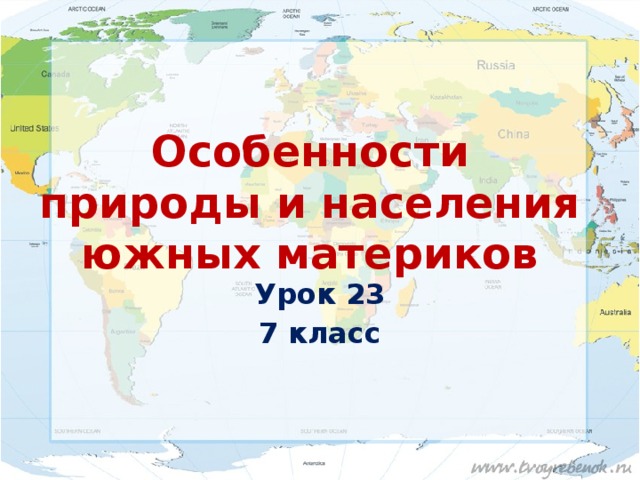
Peculiarities of nature and population of the first continents
Lesson 23
7 class
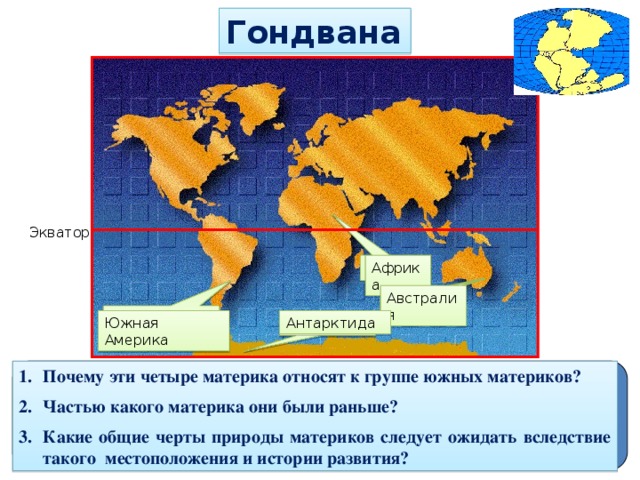
Australia
Antarctica
Pivdenna America
- Why should the mainland be taken to the group of the new continents?
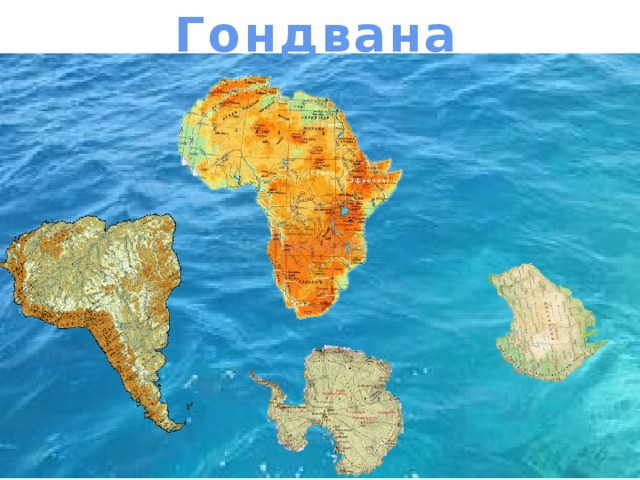

Zavdannya 1. Lesson 22, worker zoshit, side. 52, no. 1.2.
- Climate is the nature of the soil cover, the distribution of natural zones with growing flora and fauna.
- Name the natural rice of the early continents?
- 3 continents (Pivdenna America, Africa, Australia) roztashovuyutsya close to the eqvor, to that there are high temperatures stretching out to the rock.
- A large part of the continents has been roasted in the subquatorial and tropical zones, Lish vuzka smuga Pivdennoi America to enter the pomirniy belt.
- Antarctica is the single continent of the Earth, which grows close to the Pole Pole, which will summarize the vinyatka suvority of its nature.

Korisny copalini of the ancient continents
siege:
- naphtha and natural gas,
- phosphorite,
- Kam'yane and Bure Wugilya .
magmatic:
- ores of black and colore metals,
- diamonds,
- gentry ridki threw.

Internal waters of the continent. Zavdannya 2. Lesson 22, the worker is busy, side. 52, no. 3.4.
- In which oceans carry the waters of Africa and the Middle Ages? To what? Name the most common rivers of the mainland.
- Are there few rivers and lakes in any climatic belt? Is there a dumb thing on the continent?
- How can people be victorious about the ground waters, which there is a surplus in the nadra of the old continents?
Internal waters of the mainland (rivers, lakes, underground waters, ice floes) lie down to the climate and relєfu.
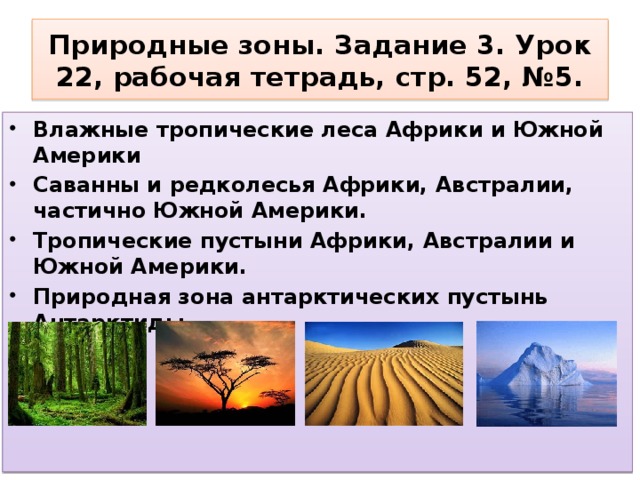
Natural zones. Zavdannya 3. Lesson 22, the worker is busy, side. 52, no. 5.
- inology tropical fools Africa and Indian America
- Savani and native African, Australia, private American.
- Tropical wilderness of Africa, Australia and Old America.
- Natural zone of Antarctic kestrels of Antarctica


- What are the special features of the DP of the first continents?
- Name the landmarks of the history of the ancient continents. Chim stench to explain?
- There is a large part of the continent in some klimatic belts, but in some mensha?
- How can the nature of the current flow?
- Yak natural zones and occupy a large area and why?

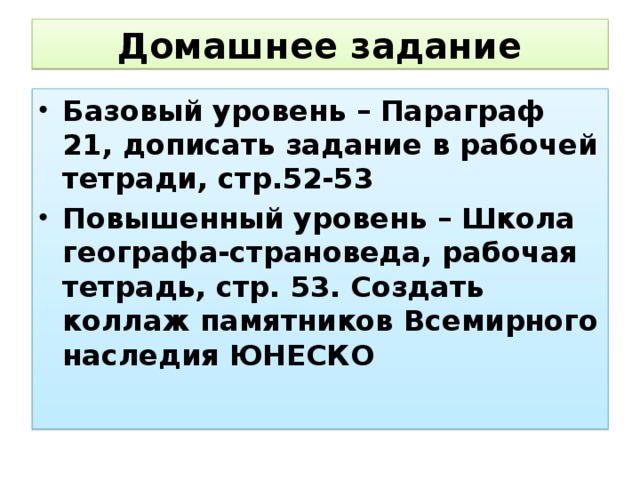
- Basic Riven - Paragraph 21, add the work-in-progress, pp. 52-53
- Pidvishcheny Rivn - School of geographer-krainnozavtsiv, working zoshit, st. 53. Create a collage of monuments of the All-Holy decline of UNESCO
Revision in the place of the presentation
"Lesson 24. Peculiarities of nature and population of the Pivnich continents 7"
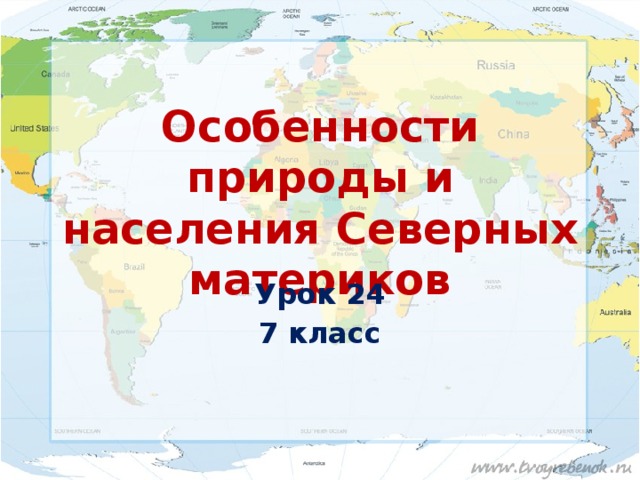
Peculiarities of nature and population of the Northern continents
lesson 24
7 class


Pivnichna America
Laurasia
Eurasia
- Why should two continents be brought to the group of private continents?
- Part of the mainland, did the stinks bully earlier?
- What kind of fabulous rice of the nature of the continent has passed since then, how has such a development and history been developed?
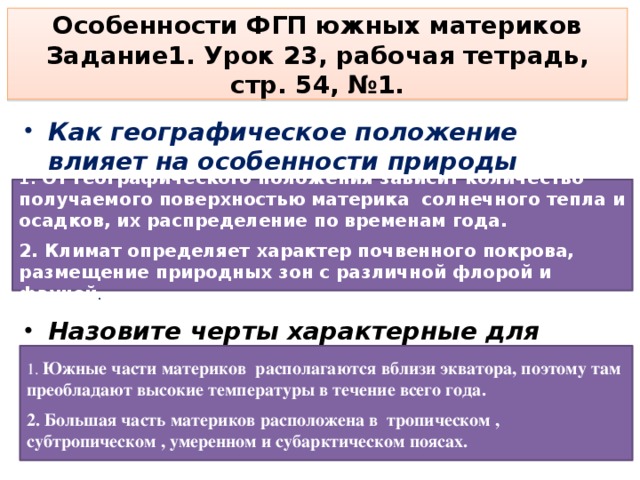
Peculiarities of the FGP of the ancient continents Zavdannya 1. Lesson 23, worker zoshit, side. 54, no. 1.
- What is the geographic location of the inflow to the particularity of the nature of the continent?
- Name the rice characteristic of the nature of the winter continents
- Due to the geographical position, there is a bit of sleepy warmth and fall, which rose behind the pores of rock.
- Climate is the nature of the soil cover, the distribution of natural zones with the growth of flora and fauna .
1. The small parts of the continent are growing close to the ekvore, so there are high temperatures, stretching out the rock.
2. A large part of the continent is roasted in the tropical, subtropical, wooded and subarctic belts.
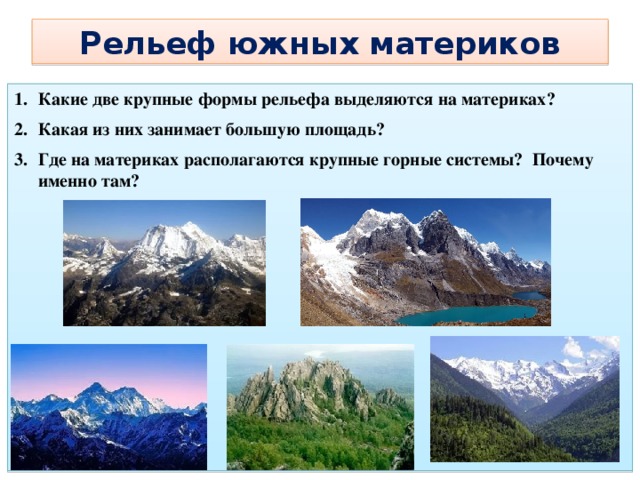
- Do you see two great forms of relfu seen on the continents?
- What do you borrow from them a large area?
- Do great girski systems grow on the continents? Why is it there?
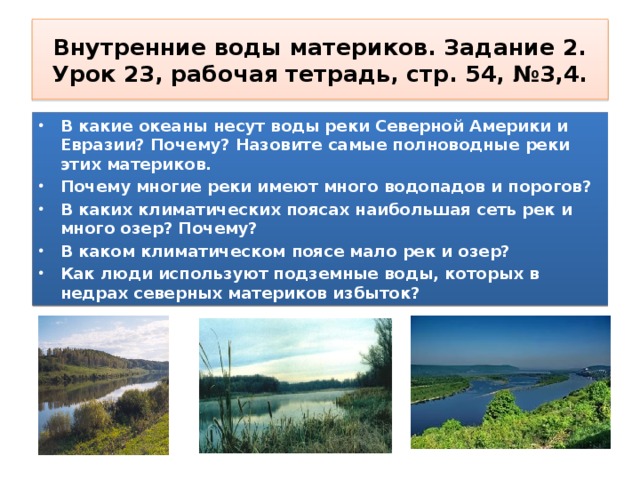
- In which oceans carry the waters of the Little America and Eurasia? To what? Name the most common rivers of the mainland.
- Why is it rich in waterfalls and thresholds?
- In some of the most climatic belts of the most common hedgehog and rich lakes? To what?
- Are there few rivers and lakes in any climatic belt?
- How can people be victorious about the ground waters, which in the nadra of the northern continents is surplus?

- arctic wilderness
- Tundri і Lisotundri
- Lisova zone
- Listep and Steppe
- Empty and empty
- Savani і rіdkolіssya
- vologі lіsi
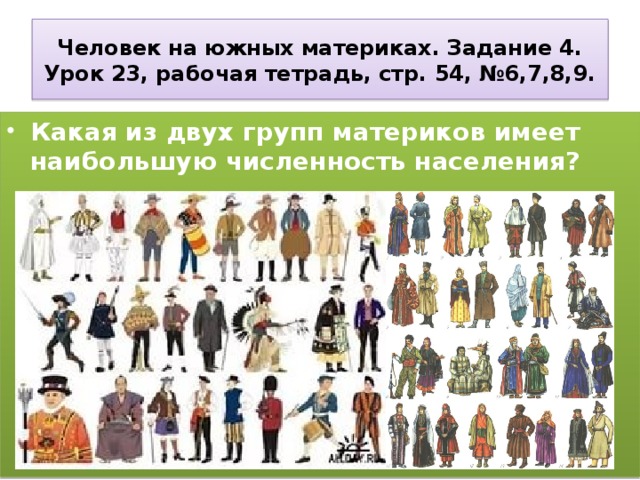
- Yaka from two groups of the continent, there is the greatest number of population?
- For a physical card, explain the rosetting of gir systems in Eurasia and Pivnichniy America.
- Using the text of the handler, name the reasons for the reasons in the nature of the continents of the Pivnichnoe Pivkul.
- Why cultural growth - victories from Eurasia and Pivnichnoy America - development?

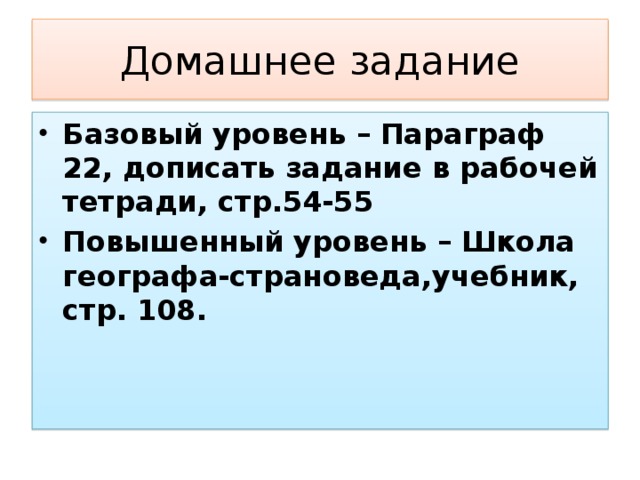
- Basic Riven - Paragraph 22, add the work-in-progress, pp. 54-55
- Pidvishcheny Rivn - School of geographer-krainnoznavtsiv, pidruchnik, st. 108.
